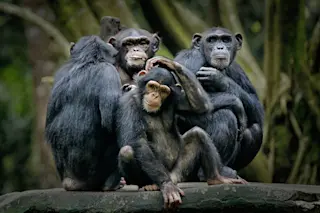Kanzi is a linguistic all-star among apes. From an early age, the captive bonobo learned over 400 symbols representing words, which he points to, in order to communicate with people. He understands even more spoken English and basic grammar, and followed verbal directions as well as a 2-year-old human during a study conducted in the late 80s.
Having watched Kanzi clips more times than I care to admit, I’m ceaselessly amazed by his communication skills. But still, as the most linguistically talented ape, he’s just on par with a run-of-the-mill toddler. Kanzi may comprehend around 1000 words, but there are over 170,000 in the Oxford English Dictionary.
So what — if anything — does this say about the communication abilities of primates? And what —if anything — does primate communication reveal about the evolution of human language?
Kanzi points to symbols that represent words (Credit: Great Ape Trust of Iowa)
...














